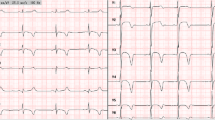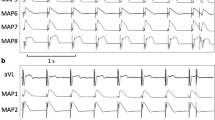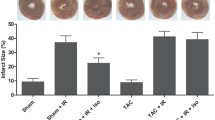Abstract
The effects of sevoflurane and halothane on the effective refractory period (ERP) and ventricular activation were examined in a canine myocardial infarction model. Sevoflurane (1 MAC) reduced the heart rate and prolonged ERP in both normal and infarcted zones. A prolongation of ERP with sevoflurane was observed also during atrial pacing at a fixed rate, but the effect was less than during sinus rhythm. Sevoflurane either further delayed or blocked the delayed activation entirely in the infarcted zones with only slight effects on the activation of the normal zones. Halothane (1 MAC) prolonged ERP during sinus rhythm and atrial pacing, but to a lesser extent during the latter. Halothane also depressed ventricular activation in the infarcted zone during atrial pacing. In conclusion, sevoflurane as well as halothane selectively depresed the delayed activation and the prolongation of ERP in myocardial infarction, which may inhibit ventricular arrhythmias in myocardial infarction.
Similar content being viewed by others
References
Hauswirth O (1969) Effects of halothane on single atrial, ventricular and Purkinje fibers. Circ Res 24:745–750
Reynolds AK, Chiz JZ, Pasquet AF (1970) Halothane and methoxyflurane—a comparison of their effects on cardiac pacemaker fibers. Anesthesiology 33:602–610
Atlee IJ, Rusy BF (1972) Halothane depression of A-V conduction studied by electrograms of the bundle of His in dogs. Anesthesiology 36:112–118
Atlee JL, Alexander SC (1977) Halothane effects on conductivity of the AV node and His-Purkinje system in the dog. Anesth Analg 56:378–385
Turner LA, Zuperku EL, Purtock RV, et al. (1980) In vivo changes in canine ventricular cardiac conduction during halothane anesthesia. Anesth Analg 59:327–334
Pruett JK, Mote PS, Grover TE, et al. (1981) Enflurane and halothane effects on cardiac Purkinje fibers. Anesthesiology 55:A65
Goto Y, Tujinaga H, Yokota S, et al. (1984) Effect of halothane on the ischemic-induced conduction delay in canine myocardium (in Japanese, with English abstract). Masui (Jpn J Anesthesiol) 33:1317–1321
Turner LA, Bosnjak ZJ, Kampine JP. (1987) Actions of halothane on the electrical activity of Purkinje fibers derived from normal and infarcted canine hearts. Anesthesiology 67:619–629
Deutsch N, Hantler CB, Tait AR, et al. (1990) Suppression of ventricular arrhythmias by volatile anesthetics in a canine model of chronic myocardial infarction. Anesthesiology 72:1012–1021
Brukner JB, Kielmann D, Gess W (1970) Sevoflurane: effects on the circulation and myocardial oxygen consumption with halothane. In: proceedings of the Central European Congress of Anesthesiology, Innsbruck, Austria
Imamura S, Ikeda K (1987) Comparison of the epinephrine-induced arrhythmogenic effect of sevoflurane with isoflurane and halothane. J Anesth 1:62–68
Kazama T, Ikeda K (1988) The cardiovascular effects of sevoflurane with halothane and isoflurane. J Anesth 2:63–68
Harris AS (1950) Delayed development of ventricular ectopic rhythm following experimental coronary occlusion. Circulation 1:1318–1324
Freeman LC, Muir WW (1991) Effects of halothane on propagation on Purkinje fibers and at Purkinje-muscle junctions: relationship of\(\dot V\)max to conduction velocity. Anesth Analg 72:5–10
Lynch C, Vogel S, Sperelakis N (1981) Halothane depression of myocardial slow action potentials. Anesthesiology 55:360–368
Hashimoto H, Satoh N, Nakashima M (1991) Coupling intervalrelated effects of class I antiarrhythmic drugs, mexiletine, cibenzoline and disopyramide, on ventricular activation in canine myocardial infarction. Jpn J Pharmacol 57:463–472
Ikemoto Y, Yatani A, Imoto Y, et al. (1986) Reduction in the myocardial sodium current by halothane and thialmyl. Jpn J Physiol 36:107–121
Terrar DA, Victory JGG (1988) Influence of halothane on electrical coupling in cell pairs isolated from guinea-pig ventricle. Br J Pharmacol 94:509–514
Ozaki S, Nakaya H, Gotoh Y, et al. (1989) Effects of halothane and enflurane on conduction velocity and maximum rate of rise of action potential upstroke in giunea pig papillary muscles. Anesth Analg 68:219–225
Spray DC, Burt JN (1990) Structure-activity relations of the cardiac gap junction channel. Am J Physiol 258:C195-C205
El-Sherif N, Scherlag BJ, Lazzara R, et al. (1977) Re-entrant ventricular arrhythmias in the late myocardial infarction period. I: Conduction characteristics in the infarction zone. Circulation 55:686–702
El-Sherif N, Scherlag BJ, Lazzara R, et al. (1977) Re-entrant ventricular arrhythmias in the late myocardial infarction period. IV: Mechanism of action of lidocaine. Circulation 56:395–402
Hashimoto H, Satoh N, Nakashima M (1990) Effects of bepridil and lidocaine on the intraventricular conduction in acutely ischemic and infarcted canine myocardium. Naunyn Schmiedebergs Arch Pharmacol 342:683–690
Kroll D, Knight PR (1984) Antifibrillatory effects of three anesthetics in acute occlusion/reperfusion arrhythmias. Anesthesiology 61:657–666
Atlee JL (1987) Halothane: cause or cure for arrhythmias? Anesthesiology 67:617–618
Hunt GB, Ross DL (1988) Comparison of effects of three anesthetic agents on induction of ventricular tachycardia in a canine model of myocardial infarction. Circulation 78:221–226
Hondeghem LM, Katzung BG (1977) Time- and voltage-dependent interaction of antiarrhythmic drugs with cardiac sodium channels. Biochim Biophys Acta 472:373–398
Author information
Authors and Affiliations
About this article
Cite this article
Hashimoto, H., Imamura, S., Ikeda, K. et al. Electrophysiologic effects of volatile anesthetics, sevoflurane and halothane, in a canine myocardial infarction model. J Anesth 8, 93–100 (1994). https://doi.org/10.1007/BF02482763
Received:
Accepted:
Issue Date:
DOI: https://doi.org/10.1007/BF02482763




